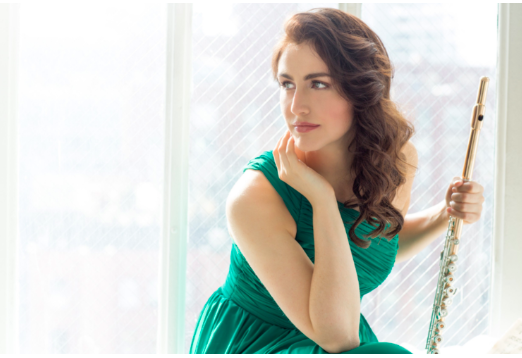Catherine Gregory, flute; David Kaplan, piano; Mihai Marcia, cello; Ian David Rosenbaum, marimba
Weill Hall at Carnegie Hall, New York, NY
November 21, 2019
What a pleasure it is to attend a performance by a stellar musician who brings to her performance a lifetime of practice, study, thought, imagination, and scrupulously arranges every detail. The more I consider Catherine Gregory’s flute recital, the more impressed I find myself.
She began with Charles-Marie Widor’s Suite for Flute and Piano, Op. 34- a perfect opener. Flute-playing enjoyed a golden age in Paris in the late nineteenth and early twentieth century, and there was a group of composers who wrote pieces to challenge and showcase the virtuosity of the players. One of the most interesting of these composers was Widor (1844-1937). Now known mostly for his organ compositions (he was a famous performer on that instrument ), he also wrote operas, symphonies, and other vocal and instrumental music. The Suite starts in a most unusual manner. A strikingly dissonant beginning makes the piece sound as if it was written long after 1884, the year of its premiere. Soon, however, it settles into a gentle tune, followed by a more animated section, and then returns to the graceful mood of the first section. I was particularly taken with the third movement, Romance: Andantino, whose lyrical beauty which shows the flute in all its glory. To show off the flutist’s technical skills, the last movement, with its rapid triplet 16th notes, first loud, then very soft, did the trick. Having convinced us of her tone, technique, intonation, and phrasing with a typical showpiece of the old school, Ms. Gregory moved on to the very new – Steady Gaze, by Timo Andres (b.1985). Mr. Andres wrote, “Steady Gaze is a catalogue of hundreds of different ways – from offhand to effusive – of saying the same thing.” This piece contains some beautiful moments and deserves to enter the repertoire.
Having presented both the old and the new, Ms. Gregory chose to end the first half with a work from the late twentieth century’s now rather passé avant garde. In 1971, George Crumb’s music was quite the rage. His wide use of extended techniques, electronics, lighting, even his themes (whales in this case) fit in with the happenings, psychedelics, and general mayhem of the years which succeeded the rigidity of the 1950’s. I didn’t expect to see him revived, but who knows? Hindemith was recently resurrected at a well-attended concert of the New York Philharmonic, something I certainly didn’t anticipate. Crumb’s Vox Balaenae (Voice of the Whale) for Three Masked Players (Electric Flute, Electric Cello, and Amplified Piano) rounded out the first half. First, the lone stagehand moved the bells, microphones, speakers, and blue lights into place. The performers then entered wearing black masks, which reminded me of those worn in old cowboy movies. But according to Crumb, “the masks, by effacing the sense of human projection, are intended to represent, symbolically, the powerful impersonal forces of nature.” The piece began with Ms. Gregory’s combined singing and flute-playing, that is, vocalizing as she played. Although I have never really cottoned to this technique, which to me only diminishes the beauty of both instruments, Ms. Gregory did it well and with great conviction. Whether or not it actually sounded like a whale, as was Crumb’s stated intention, is something I am not qualified to say. The piece, which consisted of Vocalise, Sea Theme with five variations, and Sea Nocturne (…for the end of time), went on a little too long for me, but it did contain some captivating moments. The whoosh of the stroked piano strings was highly evocative of ocean waves, and Mihai Marica’s skillful execution of the very high cello part was eerily effective. There was also some fine whistling. I’m not sure who did it (the blue-lit stage was too dark to see clearly), but I think it was Ms. Gregory. Whistling! Now there’s a neglected instrument!
After intermission, Ms. Gregory showed a fine stroke of inspiration. As she emerged from the back of the hall, she said, “Imagine you are in Arcadia,” and went on tell the story of Debussy’s Syrinx. One of the greatest pseudo-improvisations in all of music, this piece sounds different with every player. The trick is to convince the audience that you really are making it up on the spot. Ms. Gregory did this, and her performance was enhanced not only by her introduction, but also by her walking down the aisle as she played, and then gracefully sitting on the edge of the stage towards the end.
Next came Kembang Suling (Flute of Flowers) for Flute and Marimba, by Gareth Farr (b.1968.) What a perfect pairing! The marimba is intrinsically a much more compatible partner for the flute than the piano, the harpsichord, or even the harp. (Composers take note!) Ian David Rosenbaum is, like all the performers on this concert, a virtuoso. His ensemble with Ms. Gregory was uncanny to point that one wasn’t always sure which instrument was playing which note. The piece exploited this lovely union while imitating Balinese gamelan music, the sound of the Japanese shakuhachi (a kind of flute), and the complex rhythms of South Indian music.
Prokofiev’s famous, and famously difficult, Sonata in D major, Op. 94 ended the concert. It was refreshing to hear the fine David Kaplan play with full force and no hint of pussyfooting around to make way for the flute. Ms. Gregory and Mr. Kaplan nailed every virtuoso passage and played the entire piece with heroic abandon. The encore was Fauré’s Morceau de Concours. It couldn’t have been played more beautifully.

